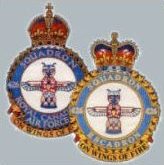
426 Squadron War History
426 Squadron formed at Dishforth, Yorkshire, England on the 15th of October 1942 and was declared operational on the 11th of January 1943.
Three days later, commencing at 22:18 hours, nine Squadron Vickers Wellingtons each carrying a mixed load of high explosives and incendiaries, started taking off on their first raid.
Led by their Commanding Officer Wing Commander S. S. Blanchard from Edmonton, Alberta the Squadron joined 113 other Bomber Command aircraft in an attack on Lorient’s U-Boat pens.
During the raid Squadron Leader C.S. Dowie of Leader, Saskatchewan and his crew were the first in the unit to drop their bombs over enemy territory. Pilot Officer G. Milne of Calgary, Alberta and his crew were lost on their way home from the raid.
In June 1943, the squadron converted to Avro Lancaster II aircraft.
The squadron’s first operation on Lancasters was on August 17th 1943 against the important target of Peenemunde, the German rocket and jet experimental station on the Baltic coast. The squadron lost two crews on this operation.
During the following nine and a half months, the squadron made 58 sorties on 58 operations.


In April 1944, the squadron began conversion to Halifax IIIs powered by four Bristol Hercules XVI engines.
On April 19th the first sorties were made in the new aircraft. Bombing operations commenced on May 7th. The squadron made 269 sorties in the Halifax IIIs.
A total of eight aircraft were lost, five over enemy territory and three over England.
On June 16th, the squadron received their Halifax VIIs and the first operation, 426 Squadron’s first daylight attack, took place on June 21st against a V1 Buzz Bomb depot.
At the end of the month railway yards and sidings at the the distant target of Metz were attacked. (Ironically. Metz became the site of the RCAFs No. 1 Air Division Headquarters in the early 1950s).
On the afternoon of Wednesday 25th of April 1945, twenty Handley Page Halifax bombers from 426 Squadron took off on what was to be the units’ last bombing raid of the war.
Led by their Commanding Officer Wing Commander C.N. Black from St. John, New Brunswick, the Thunderbirds together with 462 other bombers, attacked the coastal defences of Wangerooge Island located at the eastern end of the Frisian chain of islands.
These defences controlled the approaches to the German ports of Bremen and Wilhemshaven. At 20:06 hours, Halifax VII, NP737 “N” piloted by Flying Officer J. Boyle touched down at the Squadron’s base at Linton-on-Ouse. This brought to a close twenty seven months of sustained operations as a bomber squadron.
This last raid was not without it’s tragic consequences for the unit. An aircraft and crew captained by WO2 J.C. Tuplin from Summerside Prince Edward Island were lost.
Key events in the unit’s wartime history are as follows:
- 15 Oct 42 Formation at Dishforth, Yorkshire as the 7th RCAF bomber Squadron and equipped with Wellington III’s.
- 16 Nov 42 1st casualty. P/O W.G. Laut (Bracebridge, Ontario) killed while on a training mission with 425 (Alouette) Squadron.
- 14/15 Jan 43 1st bombing operation – target Lorient, France. P/O G. Milne (Calgary, Alberta) and crew were lost.
- 14/15 Feb 43 1st Commanding Officer, W/C S.S. Blanchard (Edmonton, Alberta) and his crew shot down by night fighter while returning from a raid on Cologne.
- 8 Jun 43 Relocated to Linton-on-Ouse, Yorkshire. 1st Canadian Squadron to be assigned Lancaster aircraft.
- 17/18 Aug 43 lst operation utilizing Lancaster IIs on a raid to Peenemunde. Commanding Officer W/C L. Crooks (RAF) and crew shot down by night fighter.


- 19 Nov 43 “Thunderbird” badge presented to Squadron.
- Apr 44 Conversion to Halifax IIIs.
- 1/2 May 44 Last operation on Lancasters with raid on marshalling yards at St. Ghislan, Belgium.
- 7 May 44 1st operation on Halifaxes – target coastal guns at St. Valery en Caux, France.
- 17/18 Jun 44 1st operation with Halifax VIIs – target V-1 supply site, Oisement-Neuville, France.
- 25 Apr 45 Last bombing operation, target Wangeroose. W02 J.C. Tuplin (Summerside, PEI) and crew were lost.
- 24 May 45 Last official day as a bomber unit.
- 25 May 45 Redesignated as a Transport Squadron within No.4(RAF)Transport Group and relocated to Driffield, Yorkshire.
Statistics:
- operational 27 months, 268 missions, 3240 sorties
- 579 casualties, 426 aircrew members killed (112 no known grave, 314 buried in 49 cemeteries in seven countries)
- 91 aircraft lost (20 Wellingtons, 33 Lancasters, 38 Halifaxes) 191 personnel awarded 198 decorations
